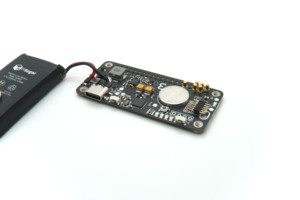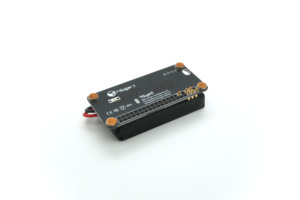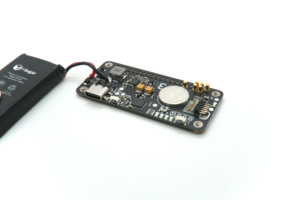(103 products available)







































































































































































There are several types of batteries suitable for the Raspberry Pi Zero that can be considered based on the requirements of specification, usability, and design.
These batteries are popular for usage with the Raspberry Pi as they are flexible and can easily be fitted into small spaces owing to their design. The distinguishing feature of LiPo batteries is that they provide a high capacity within a small volume, which permits the Pi Zero to operate for a longer time before recharging. In addition, many of these batteries come embedded with a protection circuit board, which helps protect the battery from depletion and strengthening its durability.
Li-ion batteries are a well-known choice for powering devices such as smartphones and laptops; they can also be used in Raspberry Pi systems. Similar to LiPo batteries, Li-ion can deliver lots of energy in a small package, but their shape is usually more rigid than that of LiPo batteries. They have a longer life span than LiPo batteries and are very reliable. However, they can also be slightly bigger and more difficult to integrate into a compact design. This type of battery is great for use when one wants to ensure longevity and dependability over efficiency in design.
NiMH batteries are a trusted rechargeable option; while they are not as small as LiPo or Li-ion batteries, they are larger in size and more charge-bearing within a single unit. These batteries can withstand very high loads and have a long cycle of charging and discharging. Users who want to always have a backup power source ready will find this traditional design useful and reliable. Moreover, their robustness ensures that they can be used in a Raspberry Pi-powered project that needs constant use over a long period of time.
Supercapacitors can also be found as emergency or backup power for the Raspberry Pi Zero. Although they cannot supply power for as long a period as batteries, they can recharge very quickly. That makes them fantastic for supplying temporary power while the main battery is being recharged. They can also help extend the life of a battery by taking the load away from it in power-critical applications such as real-time data logging or IoT devices.
Raspberry Pi, being a small computer, is useful in almost all branches of life and industry. Batteries give the RPi Zero the ability to function, especially when it needs to be mobile or is not easily plugged into the wall socket.
Many people use Raspberry Pi in the Internet of Things (IoT) and edge computing. Because many Pi Zero options require batteries, it is perfect for remote sensors or small data-collecting machines that must keep moving without being plugged into an AC socket. The battery will enable it to perform its data collection and transmission functions effectively.
People who make small robots use the Raspberry Pi Zero as the control center. The Pi Zero is a small computer attached to the robot and can process many things and respond to changes in the environment. To make sure it can do its job for as long as possible, the Raspberry Pi is paired with either a Raspberry Pi Zero battery pack or a wearable phone-charger battery. This way, the robot doesn't have to stop to recharge. Batteries for Raspberry Pi Zero keep the robot working and allow the robot to keep exploring and completing its tasks even without an AC socket.
Many people use the Raspberry Pi Zero in p handheld game systems and small computing devices. They make each of these devices small and light, using the Pi Zero as a tiny computer. To make it possible for the device to be used for games or other computing tasks, they add a Raspberry Pi battery so the device doesn't have to be plugged in. It can go portable and allow users to take the game or computer with them and use it anywhere. The battery enables the Raspberry Pi Zero to power small, lightweight gadgets that users can carry anywhere.
Using Raspberry Pi Zero, many users create small and inexpensive photography and video machines. The small size of the Pi Zero makes it easy to attach or hide, but to power it, they add a battery, so it can take pictures or videos without needing to plug it in. Whether used for security, nature observations, or just a fun DIY camera project, the battery lets the Raspberry Pi Zero work, powering small camera gadgets so they don't need an AC plug.
In wearables like smartwatches or fitness trackers, the small Raspberry Pi Zero powers more than the usual simple electronics. Even though it's small, they can make the wearables last a whole day by adding a battery so they can use the technology without needing to plug it in. The battery lets the Pi Zero power complex computing and keep the device slim and light enough for comfort. It provides a way to wear advanced computing that doesn't require an AC socket.
Capacity
A good capacity allows the Raspberry Pi to operate for a long time without charging. Lithium Polymer batteries are available in different sizes, usually between 1000 and 5000 mAh. The larger the capacity, the longer the Raspberry Pi device will run on battery power. However, bigger capacities also mean a bigger, heavier battery, which isn't always good for compact designs.
Voltage
This low-power computer needs a stable voltage to run well. Raspberry Pi batteries should give out a voltage between 3.7 and 5 volts. This range is good for keeping the computer working smoothly. Any change in voltage may disrupt the device, causing it to freeze or shut down. A battery that keeps a steady voltage will ensure the Raspberry Pi behaves properly and reliably.
Form Factor
The compact shape of the battery makes it easy to fit into tight spaces, such as a handheld device or a small robot. Lithium Polymer batteries have a flexible design that can be molded into blobs that squeeze into these spaces. Everyday electronics have thicker, rectangular lithium-ion cells that don't suit this purpose. Their slim and light appearance makes Pi batteries suitable for mobile projects.
Connectors
The right attachment on the battery makes plugging it into the Raspberry Pi easier, without the need for any extra wiring. Some batteries pack a jack that simply slides into the supporting connector on the board. Pi Zero power banks use a micro USB port to provide power the same way a phone charger does. These simple connections save time and make it easy to switch batteries when needed.
Preparing the Raspberry Pi Zero
The first step involves ensuring that the Raspberry Pi Zero is ready for the battery installation. The RPi must be shut down first, and then, to avoid any static electricity damaging its sensitive parts, users should touch metal. After this, the main board can be examined to see if any tiny plugs or slots will fit the battery connections.
Connecting the Battery
The next step is to attach the battery, which requires plugging the battery into either the power port on the Pi Zero or a small adapter board. This gives an easy place to connect the battery without having to solder any wires. If using a power bank for Raspberry Pi or a battery pack, micro-USB wire should be used to connect the battery pack to the Pi board.
Securing the Setup
Now that the battery is connected, the next step is to keep everything safe and sound. Any loose wires from the battery should be tucked away so they don't get caught. Pi enthusiasts can use a small piece of sticky tape to hold the jack in place. If building an enclosed case, ensure there is space for air to flow around the battery and board to avoid overheating problems in the future.
Powering Up
Users can begin using the Raspberry Pi board once everything is firmly connected and secured. After the plugging, the tutorial says to switch the Pi Zero on to see whether it would boot up correctly with battery power. If there are any problems, users should verify the connections and ensure that no wires were accidentally detached from the board during the process of securing things. When this is done properly, the Raspberry Pi will run on battery power, ready for a mobile journey.
Regular Charging
A crucial maintenance tip is to keep the battery charged regularly. A battery will often run out of charge over time and lose its ability to hold a charge. It is essential to periodically power the Raspberry Pi device and let the battery drain fully. However, it shouldn't be left completely dead, as this can damage the internal cell structure. Users give their battery a nice, steady charge before it runs out completely to ensure it stays effective.
Monitor Battery Health
Users need to watch the battery level closely so it doesn't dip too low and risk damage. The Raspberry Pi has a built-in program that can show the current charge level on the screen or app. Using this tool makes it simple and easy to keep track. Setting a level where charging will begin automatically prevents the battery from going all the way down. This helps avoid problems with the Raspberry Pi not turning on.
Avoid Extreme Temperatures
Users must remember that super hot or freezing temperatures can really harm the battery's lifespan. The heat from the Pi board or warm weather around it could make the battery too warm. On the other hand, cold weather and temperatures below freezing could make it too cool. To prevent overheating or freezing, it's vital to keep the Raspberry Pi in a well-ventilated case and out of direct sunlight or icy winds.
Storage Precautions
Avoid covering the battery by putting it in a case with the Raspberry Pi; a reasonable method must be employed to ensure the battery stays in good condition. If the battery is fully charged and then tucked away, the charge at that stage will expand and damage some parts over time. The best method of storage is to take any Pi-, put its battery in a cool place, allow it to drop to a low state of charge, and store it.
Use the Right Charger
Always using the correct charger for your device is important. Each type of battery needs a specific charger that gives out the right amount of power. A charger that gives out too much power will damage the battery, and a charger that gives out too little power will cause the battery to become weak and useless.
Avoid Overcharging
Overcharging a battery is harmful because it causes the battery to become weak and useless. People always leave gadgets plugged in, thinking this helps. But many modern batteries stop taking in power when they're full, which protects them from damage. However, traditional NiMH or Lithium batteries can become weak when overcharged. To prevent this from happening, one needs to get a special charger designed for that kind of battery to stop overcharging.
Keep Away from Excess Heat
The heat level on the battery is very important for its durability. When the battery gets heated up, this leads to thermal runaway, which is a common cause of battery damage. Many gadgets have heat sinks or fans that help keep them cool. Keeping the Raspberry Pi and its battery in a well-ventilated case will help it run properly cool and increase its lifespan.
Check for Damage
It's vital to regularly check the wires and coverings of the battery for any possible deterioration or signs of wear. Weak or broken batteries can pose safety risks because they may even explode or perhaps cause fire. Many users make a habit of checking the status of their power source. They also switch it for a new one if they notice any danger signs.
Turn Off When Not in Use
Avoid using the Raspberry Pi so that the power bank doesn't get depleted. Turn off the board so the battery doesn't provide any power to anything. Always do this before putting the device away for a long time. It saves power and also helps prevent the battery from becoming dead or damaged. Some Pi gadgets have a switch that makes turning them off easy.
One can use the Raspberry Pi Zero model with a battery and without plugging it into the AC mains. It will use a small amount of power and work fine on battery alone.
The amount of time it will run on a battery depends a lot on what people use it for and the type of battery they have. If using a low-power program and a big battery, it could run for up to 12 hours or more.
Lithium-ion or Lithium polymer batteries work well for this low-power device. They provide steady power and come in sizes that fit compact projects.
A micro USB charger plugged into the battery power bank charges the battery and powers the Pi at the same time.
Yes, there are battery packs for phones with a micro USB connector that can power the low-powered Raspberry Pi and keep the battery charged at the same time.